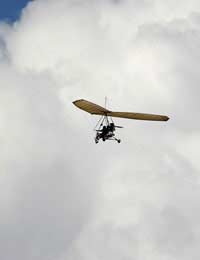Microlights

There is much confusion concerning terminology with regard to microlights. Different aviation authorities have different names and different regulations for these flying machines.In the UK we refer to these flying machines as microlights in their two basic design forms - 3 axis and weight shift.
Designed by NASA
Microlights originally evolved from hang gliders and were initially simple airframes controlled by weight shift. Such machines are still available and still flown today. They closely resemble a hang glider in construction with the addition of the passenger and engine carrying pod underneath. It is worth mentioning that the sport of hang gliding developed as a direct consequence of the NASA programme for manned space flight in the 1950s and 1960s. The delta wing that we associate with hang gliders and weight shift microlights were devised as a way of returning the space capsule safely to earth. In fact the method was discarded by NASA but adopted by others.Safety First
The pilot, and passenger if carried, of these weight shift microlights need to be suitably attired as they are not protected by a cabin. Crash helmets need to be worn with visor protection as there is no windshield. The performance of these machines is impressive in the short take off roll required and the rate of climb achieved but the overall speed and endurance once airborne is not so good.Microlights are often unfairly thought to have a poor safety record. Certainly early airframes were not robust and because of their overall weight, microlights were exempt from a lot of the CAA maintenance and licensing requirements. However, statistics reveal that they do in fact have a better safety record than many other general aviation sectors. There are more microlights on the general aviation register maintained by the CAA than any other category of general aviation aircraft - it is a popular past-time.
Pilots of microlights tend to be genuine enthusiasts who care about safety. A lot of general aviation pilots who can longer maintain a class 2 medical go on to fly microlights as the medical requirements are not as stringent. Others fly microlights because of the lower associated costs than fixed wing or rotary aviation. Some fly microlights simply because they are such enthusiasts.


Re: Aircraft General & Principles of Flight
how old do you have to be and how much is a lesson
Re: Aircraft General & Principles of Flight
Give the types of aircraft engines and its performance